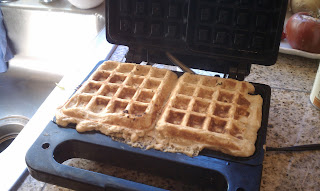 |
| Two in a Bowl: Pumpkin & Potato Leek Soup |
What’s better than one soup? That’s right. Two soups… in the same bowl. For some, this might just be the adventure you need to take. It’s kind of amazing. The night after I made pumpkin soup, I decided to make another batch of it (because it was just that good) and also give AW’s potato leek recipe another go. The last time I made it, it turned out a bit thick as I think my potato-to-leek ratio was a bit off. This time though I think I got it just right, and am excited to share it with you all!
When it comes to cooking with leeks, I think it is all about having enough leeks (which I have often not gotten enough of) and being able to pick out good ones at the market. If you are new to cooking with leeks, don’t be scared of them, they are really just a sweeter version of an onion. When you go shopping for them, aim to pick out the ones with the longest white stalk, because this is part you are going to cook with. All the green leafy-sides can be put aside for vegetable stock, but when a recipe calls for leeks, more often than not, it is calling mostly for the white part. (Check out the link to the magic leek soup below to see how to properly cut and wash leeks.)
I think of leeks as a bit of a superfood. Besides being the only ingredient in the
magic leek soup of Mireille Guiliano’s
“French Women Don’t Get Fat” book (also great when you are in the need of a little detox), they are also loaded in nutrients. (On a personal note I will be resorting to this detox soup after the upcoming Seattle Restaurant week where I plan to eat my way around the city.) From a nutritional perspective, leeks contain active substances (allyl sulfides) which block the action of hormones and chemical pathways within the body that promote cancer. Regular consumption of allium vegetables (onions, garlic, shallots, leeks etc.) are also associated with a reduced risk of both prostate and colon cancers, decreased tendencies for blood clots to form and lower levels of LDL (the bad) cholesterol. Leeks are also a good source of the most important carotenoids for eye health (lutein and zeazanthin)… so basically, eat your leeks…
Potato & Leek Soup
1. Trim off the root end and the upper greens of the leeks (see picture) and quarter halfway down the leek so in order to wash off any dirt from the outside and inner leek sections.
2. Wash off the leeks in water
3. Cut up about
3 pounds of leeks (I purchased 3.15 lbs and somewhere between 4-5 medium width leeks) which should amount to about 4-5 full cups of thinly sliced leeks. Set aside.
4. In a heavy-bottomed pot (I used my dutch oven), melt
3 T. of butter. (You can use unsalted or salted here, not an issue).
5. Add
4-6 springs of fresh thyme (if possible) removing the leaves by moving your fingers backwards down the bark. Also add
3-4 bay leaves. (Remember how many bay leaves you put in, because you will need to fish these out later.) Let these mix up with the butter for a minute or two, then add leeks.
6. Cook for about 10 min. Then add about
4 cups of coarsely diced yellow potatoes (about 1 pound). AW says to peel them, but when you do you lose a lot of interesting texture to the soup, not to mention a lot of nutritional value.So I leave the skins on...
7. Cook for about 4 min, then add about 5 cups of water, bring the soup up to a boil, then turn down to a simmer for about 30 min, or until vegetables are tender. Fish out bay leaves after the 30 min.
8. Once done, use a hand blender (or normal blender in batches) to puree the soup to your desired consistency, then season with lots of
good salt and cracked pepper.
9. Some people suggest adding a 1/3 of crème fraiche or heavy cream, but I have tried it like this and don’t think it makes a difference. I suggest not using any cream the first time making it.
You can serve this as a “two-in-a-bowl” as previously suggested or perhaps on its own. While it is an excellent soup to take to work as leftovers, or just to have for dinner, I would suggest if you are feeling sassy, you should jazz it up with some white truffle oil. You don’t need much at all, but a drizzle on the top of the soup just adds that some extra, and might make you fall in love with white truffle oil forever. I use the Bartolini brand that I get down at La Buona Travola in Pike’s Place.
 |
| Potato Leek Soup with White Truffle Oil |
Bon Appétit!
Tastes: Amazingly rich despite no addition of cream. I think the three keys to this soup are your potato to leek ratio (more leeks, more flavor I find), lots of salt and cracked pepper and heavy pureement of soup with the blender. Yum.
Total Prep/Cooking Time: 55 min, including 30 minutes of it just simmering
Total Cost: Exactly $9.45 + bay leaves & thyme (both of which I grow) but I would assume perhaps another $5 for these and you will likely be left with extras.















